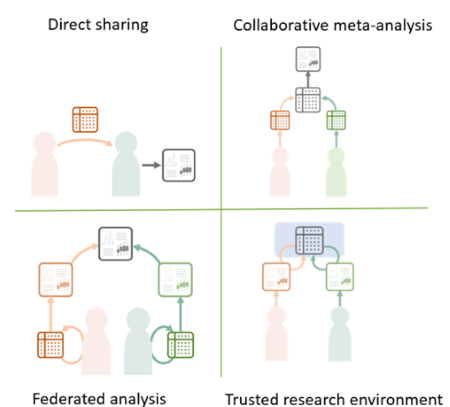Rethinking Data Sharing: Flexible Models for Research Collaboration
This post introduces four flexible models for sharing research resources; direct sharing, collaborative sharing, federated analysis, and trusted research environments (TREs). By exploring these fit-for-purpose approaches, researchers can choose methods that align with ethical, legal, and practical considerations, especially when working with sensitive data or biospecimens. ADBEx supports all these models to promote equitable and secure research collaboration.

Not All Resource Sharing Looks the Same
When people think about sharing research resources like datasets or biospecimens, they often picture simply sending a file or physical sample to someone else. But that’s just one approach. At ADBEx, we encourage researchers to think more creatively and flexibly about how resources can be shared, depending on the sensitivity, context, and goals of their work. There are several fit-for-purpose models available, each offering different levels of openness, control, and collaboration.
Four Ways to Share Research Resources
1. Direct Sharing
This is the most familiar model: a researcher gives another researcher a copy of the resource. It’s straightforward, but it can carry privacy, consent, and governance risks, especially for sensitive materials like health data or biospecimens.
2. Collaborative Sharing
Here, instead of transferring the resource, researchers form a partnership. Each team retains control of its own materials but works together, for example, by contributing to a shared analysis or a multi-site study.
3. Federated Analysis
With this model, the resource stays in place and the analysis moves. Each site runs the same code locally, and only the results are shared. This protects privacy and can sidestep legal or ethical barriers to sharing raw materials across borders.
4. Trusted Research Environments (TREs)
Resources are stored within a secure digital environment with strong access controls. Researchers can log in to analyze the material, but they can't download it. Only de-identified, aggregated outputs leave the platform.
Why It Matters for ADBEx
When you share resources through ADBEx, you’re not locked into a single model. Whether you're thinking about participant confidentiality, regulatory constraints, or fair collaboration, there's a sharing approach that can meet your needs.
We’re here to support flexible, ethical, and equitable research partnerships no matter what form your resource sharing takes.
Want to Learn More?
This blog post is based on the article:“Multiple modes of data sharing can facilitate secondary use of sensitive health data for research” – Tamuhla et al. (BMJ Global Health, 2024)
No listings found
Try broadening your search parameters